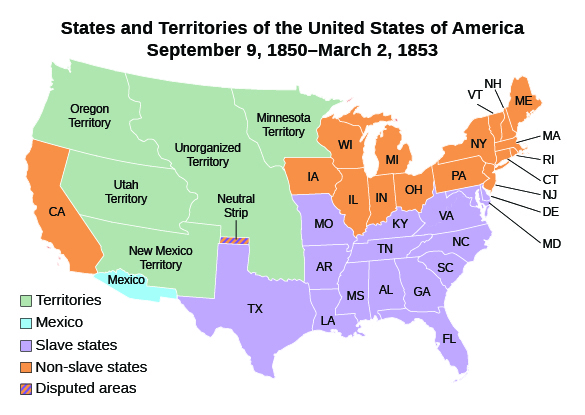| << Chapter < Page | Chapter >> Page > |
President Taylor and Henry Clay, whose resolutions had begun the verbal fireworks in the Senate, had no patience for each other. Clay had long harbored ambitions for the White House, and, for his part, Taylor resented Clay and disapproved of his resolutions. With neither side willing to budge, the government stalled on how to resolve the disposition of the Mexican Cession and the other issues of slavery. The drama only increased when on July 4, 1850, President Taylor became gravely ill, reportedly after eating an excessive amount of fruit washed down with milk. He died five days later, and Vice President Millard Fillmore became president. Unlike his predecessor, who many believed would be opposed to a compromise, Fillmore worked with Congress to achieve a solution to the crisis of 1850.
In the end, Clay stepped down as leader of the compromise effort in frustration, and Illinois senator Stephen Douglas pushed five separate bills through Congress, collectively composing the Compromise of 1850. First, as advocated by the South, Congress passed the Fugitive Slave Act, a law that provided federal money—or “bounties”—to slave-catchers. Second, to balance this concession to the South, Congress admitted California as a free state, a move that cheered antislavery advocates and abolitionists in the North. Third, Congress settled the contested boundary between New Mexico and Texas by favoring New Mexico and not allowing for an enlarged Texas, another outcome pleasing to the North. Fourth, antislavery advocates welcomed Congress’s ban on the slave trade in Washington, DC, although slavery continued to thrive in the nation’s capital. Finally, on the thorny issue of whether slavery would expand into the territories, Congress avoided making a direct decision and instead relied on the principle of popular sovereignty. This put the onus on residents of the territories to decide for themselves whether to allow slavery. Popular sovereignty followed the logic of American democracy; majorities in each territory would decide the territory’s laws. The compromise, however, further exposed the sectional divide as votes on the bills divided along strict regional lines.
Most Americans breathed a sigh of relief over the deal brokered in 1850, choosing to believe it had saved the Union. Rather than resolving divisions between the North and the South, however, the compromise stood as a truce in an otherwise white-hot sectional conflict. Tensions in the nation remained extremely high; indeed, southerners held several conventions after the compromise to discuss ways to protect the South. At these meetings, extremists who called for secession found themselves in the minority, since most southerners committed themselves to staying in the Union—but only if slavery remained in the states where it already existed, and if no effort was made to block its expansion into areas where citizens wanted it, thereby applying the idea of popular sovereignty ( [link] ).


Notification Switch
Would you like to follow the 'U.s. history' conversation and receive update notifications?